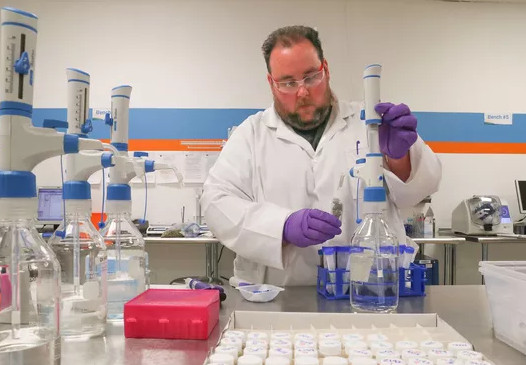Nicholas Hughes used to sell a cannabis treat fit for a king: The Elvis, a chocolate cookie infused with 1,000 milligrams of mind-altering THC – 100 times what is now the per-serving dosage limit in California.
“You could not keep them on the shelf,” he said.
But earlier this month, Hughes’ dispensary, Cathedral City Care Collective North, parted ways with the cookie, one of tons of cannabis products that can’t be sold since California phased in new testing, packaging and dosing standards on July 1. For edibles like The Elvis, the state now imposes a limit of 10 milligrams of THC per serving and 100 milligrams of THC per package.
Marijuana companies in California had a six-month grace period to sell weed harvested or processed before 2018. With the cut-off date looming on July 1, retailers hustled to sell old cannabis at fire sale prices, then swept the leftovers off their shelves and dumped them in the trash.
Now the companies face another challenge: Restocking. But with increased demand for compliance tests causing a bottleneck at labs, dispensaries that used to fill every inch of their display cases now fear a supply shortage.
“We probably have a quarter of what we usually have,” Hughes said.
Other retailers have seen their product variety shrink as much as 90 percent. “I’m getting pictures every day of retailers that went from 45 strains to 5,” said Jerred Kiloh, President of the United Cannabis Business Association.
The transition to stricter testing has been a bonanza for cannabis testing laboratories. Greg Magdoff, the founder of PharmLabs Cannabis Testing, said desperate dispensary owners have called him, “crying on the phone like, ‘Dude, help, I can’t fill my shelves.’”
Other calls come from panicked lab customers demanding faster processing times.
“Lots of people are scrambling,” said Josh Swider, co-owner of San Diego-based Infinite Chemical Analysis Labs. “They’re calling me every ten minutes saying, ‘Where’s my sample? Where’s my sample?’”

Credit: www.desertsun.com
The bottleneck could belie an imbalance in the legal cannabis market. While 599 temporary manufacturing licenses and 3,105 temporary cultivation licenses are active in California, the state has only granted 31 temporary licenses for labs. Confronted with rising demand after July 1, lab managers have spent the past three weeks staffing up, only to find their turnaround times are still double or triple what they were before the new regulations.
“Every lab is backlogged,” Swider said. “There’s only so fast we can run.”
When the state’s testing rules are in full effect at the end of this year, California labs will have to test for 66 residual pesticides, 20 residual solvents and processing chemicals, four heavy metals and three kinds of microbes – not to mention water and moisture as well as the chemicals that give cannabis its smell, taste and psychoactive properties and contaminants like dirt, mold and rodent hair.
Labs are also charged with measuring homogeneity – that is, whether the same concentration of THC is contained in each serving of an edible.
The samples don’t always pass. At different labs, pesticides, incorrect labeling and lack of homogeneity were all cited as causes of failure.
Swider estimates as much as half of marijuana flower and 90 percent of marijuana distillates in Southern California won’t pass the compliance tests implemented July 1.
Even companies diligent about compliance might not make the cut. Swider recalls one customer failed a test because it used an organic tangerine tincture that turned out to contain pesticides.
“You’ve got to source all clean product,” Swider said.
Lab managers say state testing thresholds are so strict, their businesses have to use cutting-edge equipment to catch tiny concentrations of contaminants. And once a problem is detected, diagnosing its source might not be easy.
Magdoff, whose company has three labs in California, said some air filtration systems fail to catch contaminants, for example, especially in windy places like the Coachella Valley.
“The wind is ridiculous,” he said. “All the sand and all the dirt from all the fields – there’s pesticides in there. All the cattle – you’ve got E. coli and all these bacteria and microbes.”
Packaging and labeling is another challenge.
At CW Analytical, an Oakland laboratory, CEO Robert Martin said a big challenge for his customers has been making sure the amounts of CBD and THC in their products match the numbers on their labels, within certain bounds. Martin said about 10 percent of samples fail, the vast majority because the THC claim made on their labels doesn’t match the lab’s analysis.
“It’s really hard to have these really top notch regulations on an industry that is struggling to get to the level we want it to be at,” Martin said.
But Martin has misgivings about his lab’s role in enforcing label claims, a time-consuming function he thinks should be the state’s responsibility.
“We’ve become an agent of the state, essentially,” he said. “I’m uncomfortable with that. I’ve become a cop all of a sudden.”
Tom Adams, Managing Director of cannabis industry research firm BDS Analytics, said the lesson to other states rolling out a legal marijuana market is simple: Relax.
“This is not heroin, you know?” he said. “To respond to cannabis’s misguided inclusion in Schedule 1 of the Controlled Substances Act for the past 50 years by over-regulating and over-taxing it is an enormous mistake if the goal is to legalize a largely illicit business.”
Adams thinks tight regulations make it harder for legal businesses to compete with the black market. But no matter what states do to legalize cannabis, he said, bumps in the road are inevitable.
“Is there a way out?” he said. “I don’t think there is.”
Amy DiPierro covers real estate and business for The Desert Sun. Send her a message at amy.dipierro@desertsun.com or 760-218-2359. Follow her on Twitter @amydipierro.
Credit: www.desertsun.com


